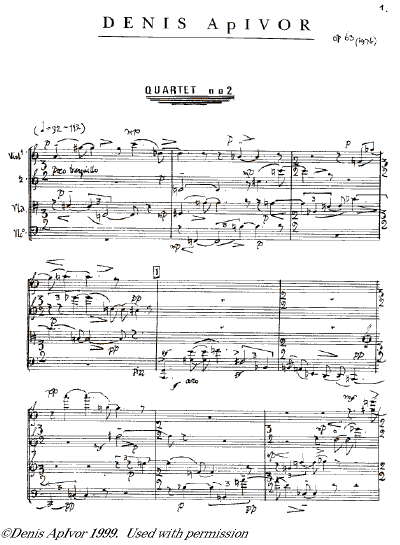|
<< -- 3 -- Gordon Rumson THE TIDE IS TURNING

The Second Quartet, written in 1975 is in a demanding serial
style, while the Third, written in 1989, follows a different course.
By that time ApIvor had relinquished serial methods and pursued
a process of simplification. Patrick Harrex says 'The performers
recognize the challenges of the music but have responded with
enthusiasm to these fine works. The depth of musical invention
far outweighs the technical issues involved.'

The first page of the Quartet No 2 Op 63 (1975). © 1999 Denis ApIvor, all rights reserved. Used with permission.
|
It is hard to imagine that a composer of Denis ApIvor's achievements
can have been neglected, but evidently the tide is turning. With
more performances, essays and reviews appearing, Denis ApIvor's
creativity can begin to be measured. There is so much music to
be heard (far too many works even await their première). Further,
ApIvor's reach was broad and Dr Marrington finds his contributions
to British music diverse, with a large body of songs in the 1930s,
the setting of 'difficult' poets such as T S Eliot and Dylan
Thomas, along with his remarkable contribution to the repertoire
for the guitar. But, according to Marrington, ApIvor also persevered
in 'exploring serial techniques in the 1940s and 1950s when
there was still hostility to the method.' ApIvor created
'highly expressionistic' theatrical works in the 1950s
and then later applied Webern-esque techniques to theatre as well.
Continue >>
Copyright © 20 April 2004
Gordon Rumson, Calgary, Canada

|

